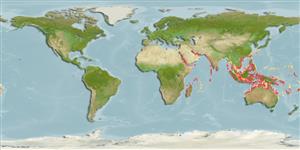Actinopterygii (ray-finned fishes) >
Perciformes (Perch-likes) >
Gobiidae (Gobies) > Gobiinae
Etymology: Amblyeleotris: Greek, amblys = darkness + The name of a Nile fish, eleotris (Ref. 45335); diagonalis: From the Latin 'diagonalis' referring to the oblique bands on the body.
Environment / Climate / Range
Ecology
Marine; reef-associated; depth range 6 - 40 m (Ref. 48637). Tropical, preferred ?
Indo-Pacific: Kenya, Madagascar, Red Sea, Persian Gulf, Sri Lanka, Born Island, Andaman Sea; Guadalcanal, Solomons; Flores, Indonesia; south to the Great Barrier Reef.
Size / Weight / Age
Maturity: Lm ? range ? - ? cm
Max length : 11.0 cm SL male/unsexed; (Ref. 48637)
Dorsal
spines
(total): 7;
Dorsal
soft rays
(total): 13;
Anal
spines: 1;
Anal
soft rays: 13. Characterized by whitish body color; snout and cheek with pair of thin, slanting dark brown bands, five wider brown bands on side with few brown spots between each band; anal fin yellow with blue margin; low basal membrane joins pelvic fins; predorsal scales extending forward to above posterior margin of preopercle; longitudinal scale series 67-75; greatest depth of body 5.2-6.7 in SL; caudal fin 2.8-3.6 in SL (Ref. 90102).
Lives with symbiont alpheid shrimps which prepare and maintain burrows in sand or sand and rubble areas (Ref. 9360). Found in coastal to outer reef sand slopes (Ref. 48637).
Life cycle and mating behavior
Maturity | Reproduction | Spawning | Eggs | Fecundity | Larvae
Randall, J.E. and M. Goren, 1993. A review of the gobioid fishes of the Maldives. Ichthyol. Bull. J.L.B. Smith Inst. Ichthyol. (58):1-37, 5 pls. (Ref. 9360)
IUCN Red List Status (Ref. 115185)
CITES (Ref. 94142)
Not Evaluated
Threat to humans
Harmless
Human uses
More information
Common namesSynonymsMetabolismPredatorsEcotoxicologyReproductionMaturitySpawningFecundityEggsEgg development
ReferencesAquacultureAquaculture profileStrainsGeneticsAllele frequenciesHeritabilityDiseasesProcessingMass conversion
Tools
Special reports
Download XML
Internet sources
